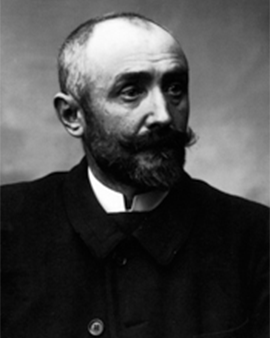


Amid the luminous and dynamic universe of Post-Impressionism, Henry Moret, born December 12, 1856 in Cherbourg and died May 5, 1913 in Paris, unleashed his rich talent. With the deft brushwork of a true master, Moret manifested himself as a celebrated landscape, floral, and marine painter of his day, whose works are now enjoying resurgence as unique fine art prints. Moret, scion of the garrison officer Edouard Moret and his wife Magdeleine, originally began his life in military service. In 1875, he served in the 62e régiment d'infanterie in Lorient. Through his commanding officer, Jules La Rousse La Villette, Moret was introduced to the marine painter Ernest Corroller. This meeting initiated Moret's artistic transformation as Corroller introduced him to the academic style of painting. Under Corroller's tutelage, Moret came to appreciate the masterpieces of earlier greats of French landscape painting, such as Jean Baptiste Camille Corot and Gustave Courbet. The open-air painting that Corroller introduced Moret to proved crucial to Moret's artistic development. In 1876, Moret, well prepared and trained by his experiences under Corroller's wing, was able to begin his studies at the prestigious École des Beaux-Arts in Paris. Here he learned the art of history painting under the masters Rudolf Lehmann, Jean Leon Gerome and Jean Paul Laurens.
Moret rose quickly and exhibited his first work, "La plage de Locqueltas à marée basse; Côte de Bretagne" (The beach of Locqueltas at low tide; coast of Brittany), at the Paris Salon in 1880. Despite his inclination at the time toward the dark, muted tones of the Barbizon School, a move to Pont-Aven in 1888 drastically changed his artistic direction. Here he was strongly influenced by the painters Claude Monet and Paul Gauguin and developed his own style, which was a blend of Impressionism and the Pont-Aven school. His relationship with the gallery owner Paul Durand-Ruel led to an impressive creative period in which he produced over 600 paintings. Many of these works found their way into galleries in Paris and New York, and a selection of seven of his Breton paintings was even exhibited at the Salon des Indépendants. Moret developed an incomparable style, characterized by effective lighting, roaring surf, and luminous sunsets. He also produced some 800 watercolors and drawings. Henry Moret's impressive works, transferred to art prints today, are a testament to his undisputed talent and inimitable style. Reproduced with the utmost precision, we can continue to admire and celebrate his artistic achievements while enjoying the breathtaking beauty and poignancy of his art.

Amid the luminous and dynamic universe of Post-Impressionism, Henry Moret, born December 12, 1856 in Cherbourg and died May 5, 1913 in Paris, unleashed his rich talent. With the deft brushwork of a true master, Moret manifested himself as a celebrated landscape, floral, and marine painter of his day, whose works are now enjoying resurgence as unique fine art prints. Moret, scion of the garrison officer Edouard Moret and his wife Magdeleine, originally began his life in military service. In 1875, he served in the 62e régiment d'infanterie in Lorient. Through his commanding officer, Jules La Rousse La Villette, Moret was introduced to the marine painter Ernest Corroller. This meeting initiated Moret's artistic transformation as Corroller introduced him to the academic style of painting. Under Corroller's tutelage, Moret came to appreciate the masterpieces of earlier greats of French landscape painting, such as Jean Baptiste Camille Corot and Gustave Courbet. The open-air painting that Corroller introduced Moret to proved crucial to Moret's artistic development. In 1876, Moret, well prepared and trained by his experiences under Corroller's wing, was able to begin his studies at the prestigious École des Beaux-Arts in Paris. Here he learned the art of history painting under the masters Rudolf Lehmann, Jean Leon Gerome and Jean Paul Laurens.
Moret rose quickly and exhibited his first work, "La plage de Locqueltas à marée basse; Côte de Bretagne" (The beach of Locqueltas at low tide; coast of Brittany), at the Paris Salon in 1880. Despite his inclination at the time toward the dark, muted tones of the Barbizon School, a move to Pont-Aven in 1888 drastically changed his artistic direction. Here he was strongly influenced by the painters Claude Monet and Paul Gauguin and developed his own style, which was a blend of Impressionism and the Pont-Aven school. His relationship with the gallery owner Paul Durand-Ruel led to an impressive creative period in which he produced over 600 paintings. Many of these works found their way into galleries in Paris and New York, and a selection of seven of his Breton paintings was even exhibited at the Salon des Indépendants. Moret developed an incomparable style, characterized by effective lighting, roaring surf, and luminous sunsets. He also produced some 800 watercolors and drawings. Henry Moret's impressive works, transferred to art prints today, are a testament to his undisputed talent and inimitable style. Reproduced with the utmost precision, we can continue to admire and celebrate his artistic achievements while enjoying the breathtaking beauty and poignancy of his art.
Page 1 / 1






